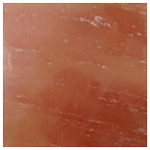Info: Himalayan Crystal Salt Block; Choice of Round or Square Shape
Himalayan Crystal Salt blocks, which have been repeatedly featured in cooking shows and competitions like 'Iron Chef America' and are increasingly being featured in high-end steak houses, can be used for a number of purposes in your kitchen, cottage, or barbequing area:
* as cutting boards, chopping blocks or serving platters to bring a unique salt flavour to a variety of food combinations;
* as a mortar-and-pestle surface that can add salt to whatever herbs, spices or other ingredients you are grinding, in the process; or,
* as a flavour-imparting oven grilling, baking, or range-top cooking surface (they can withstand temperatures of up to 900F: simply insert them in the oven or atop your stove and place the food on them and cook on them as a griddle).
* as a cold serving platform to keep charcuterie cool on a warm day (just freeze it overnight).
Product Notes:
The colours of each block are fairly consistent within each block, but not all blocks have the same colour. Block colours vary from a pale yellow/orange, to coral, to some more pink(ish), and some more orangey-brown. The images shown are representative, but natural variation will occur.
Price may vary in store.
Salt Block Cooking

To use a large Himalayan Crystal Salt Block as cookware - either in a gas or electric stove, or in an oven, or even on a counter or tabletop (if there's a trivet and drip pan, underneath) after it's been preheated by those --
1) It's very important to preheat it* to at least 450F/232C before putting food on them (otherwise, as both it and the food heat up, too much salt will get dissolved and absorbed into the food from the moisture the food emits as it's heated).
That might take about a half hour or more, depending on the oven. But some suggest it's better to use a stove or range top to do the preheating, and to a) use a pastry ring, wok ring, or some type of metal object that can withstand the heat (and weight) between the block and the element or burner; b) start at low, for about 15 minutes, when you'll see some moisture from the slab itself being emitted; then c) at medium for 5 to 10 minutes; and finally, d) 5 to 10 minutes at the highest temperature.
* (Or at least the first centimeter or so of its cooking surface; so if it was only heated from below, flip it over before cooking).

2) Once it's hot enough, cook with it as you would a cast iron skillet or flat-top griddle or a wok; preferably, with either a wooden spatula or a highly heat-resistant, non-scratching silicone spatula, for stirring or flipping items.
Bear in mind that as the meat juices and/or moisture from the meat or other food are released, they will overflow and drip, so place a cookie sheet or similar tray or pan on the rack beneath, if doing this in the oven; or find a frying or baking pan or something similar large enough to put the block in once you start cooking, to collect the drippings.
3) If you’re about to cook a very moist type of food that’ll give off a lot of liquid (like many vegetables you might stir-fry do, such as bok choy) and will not have already cooked some fatty foods like meat on the block first before adding them, brush a little of your favourite cooking oil on the block before adding any of the food (to create a partial barrier between the block and that moisture, to slow the salt absorption).
4) Cleaning: let it cool fully to room temperature before washing; that could take overnight. Rinse it under warm water. Remove from water, then scrub areas where food may be stuck or where glazing from fat or oil has occurred. Rinse with water again to wash clean. Dry with a clean rag, paper towel, or some other type of cleaning cloth. Place on drying rack, or somewhere where it can air dry.
5) Store where humidity is a minimum. (They can withstand very cold temperatures, too, so you could keep it in a porch in if it's well below freezing, or in a deep freeze, though that's not necessary).
6) Experiment! And find out more! This has become a whole genre of cooking, and entire books have been written about the subject.
Photo Credits: Craig Hatfield and Mike McCune.
Product Options:




